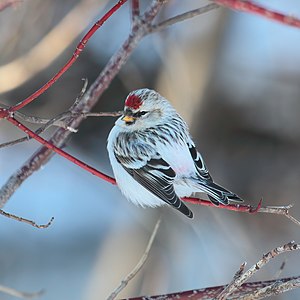Polar siskin
| Polar siskin | ||||||||||||
|---|---|---|---|---|---|---|---|---|---|---|---|---|

Polar siskin ( Acanthis hornemanni ) |
||||||||||||
| Systematics | ||||||||||||
|
||||||||||||
| Scientific name | ||||||||||||
| Acanthis hornemanni | ||||||||||||
| ( Holböll , 1843) |
The polar siskin ( Acanthis hornemanni , Syn . : Carduelis hornemanni ) is a songbird from the genus Acanthis in the finch family (Fringillidae).
description
The bird, measuring 13 to 15 centimeters , is similar to the siskin , but is lighter and appears frosted. The rump is unstripe and pure white, and the conspicuous wing bands are also white. The back is gray in color and stands out like a saddle from the light head and the light, slightly striped underside.
The breast of the male has only a faint pink tinge, the female lacks the reddish hue. Both males and females have a crimson crown. His voice is similar to that of the European Siskin , but the individual notes are more clearly separated from each other.
habitat
There are two subspecies, A. h. hornemanni from Greenland and the neighboring Canadian islands as well as A. h. exilipes from North America and Eurasia. The Greenland subspecies is larger and lighter, sometimes predominantly white. In Europe, the polar siskin breeds only in northernmost Scandinavia. In winter he can be found in all of Scandinavia and the Baltic States, wandering to Iceland, Great Britain and Central Europe.
Way of life
It is usually a tundra bird that breeds in dwarf birch and low underbrush. The clutch consists of four to five eggs, and the young are fledged after 9 to 14 days. Birch seeds, as well as insects, are the main food of the polar siskin. In several places, for example in northern Norway, it forms unlimited mixed pairs with the European siskin.
literature
- Roger Peterson, Guy Montfort, FAD Hollom: Die Vögel Europäische , Verlag Paul Parey, Hamburg and Berlin, 9th edition 1966, ISBN 3-490-05518-7 .
